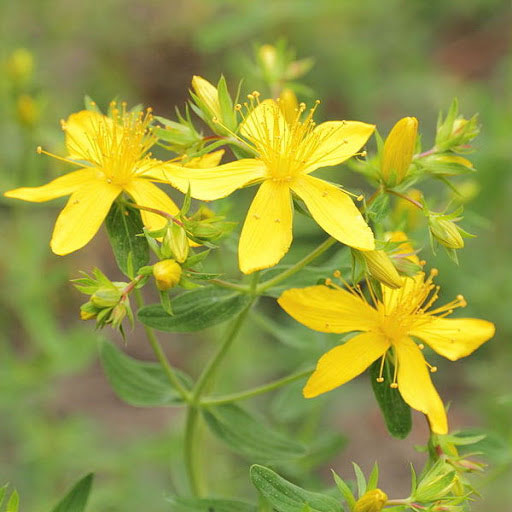Qualities: Sweet, bitter, slightly warming, astringent, alterative, anti-viral, anti-depressant, sedative, nervine.
Uses: Hypericum may be most known for it’s antidepressant effects. There is a significant evidence base for this use, and a recent metanalysis reported it is as effective as SSRI medications such as Zoloft or Prozac for mild to moderate depression. Specific extracts have been shown to be more effective than an SSRI. Anxiety, depression, tension headache, and feelings of worthlessness or disconnection are indications for this herb. Hypericum acts on the nerves, and is used for neuralgias including trigeminal neuralgia. This herb can reduce pain from compression or crush injuries, and can help pain from shingles, toothache, and ulcers. Hypericum has also been shown to have radioprotective (protects against damaging effects of radiation) qualities. Hypericum is an actively researched herb, and research is demonstrating new uses.
Warnings: Hypericum aka St. John’s Wort is a wonderful medicine, however, it interacts with many herbs and pharmaceuticals. Please DO NOT take this herb if you are on any medications, including birth control, without the advice of a healthcare professions. This herb may be the most studied herb in terms of medication interactions. It can potently affect the blood concentrations of medications — for example, it may oral birth control not effective. This occurs because the herb changes the way the liver’s metabolic paths operate; it can speed up the metabolism of some drugs, thus making them less effective. Hypericum also shares the same warnings as antidepressant drugs because it appears to inhibit the re-uptake of several neurotransmitters including serotonin. Hypericum should not be used in pregnancy and while nursing.
Description: Hypericum is a hardy, small shrub. It grows to about 3 feet tall, and is easy to cultivate. It’s bright yellow 5 pedaled flowers bloom around the summer solstice. These unique blossoms have a burst of long stamen coming from the center — cheerful! Its stalkless oval leaves are about three times longer than they are wide and have tiny pinhole glands which look like perforations — hence the name H. perforatum.
Preparations: This herb can be taken internally as a tea or tincture, however these must be prepared from fresh herb: Hypercium loses its medicinal qualities when dried. Standardized extracts are effective when fresh herb or tincture are not available. When infused in oils, Hypericum can be applied topically for viral outbreaks such as shingles or cold sores, and is also helpful for burns and other wounds.

References:
Khalil Assiri, Yagoub Alyami, James M Uyanik 2, Marcela Romero-Reyes. Hypericum perforatum (St. John’s Wort) as a possible therapeutic alternative for the management of trigeminal neuralgia (TN) – A case report. Complement Ther Med. 2017 Feb;30:36-39. doi: 10.1016/
Qin Xiang Ng, Nandini Venkatanarayanan, Collin Yih Xian Ho. Clinical Use of Hypericum Perforatum (St John’s Wort) in Depression: A Meta-Analysis. J Affect Disord 2017 Mar 1;210:211-221. doi: 10.1016/j.jad.2016.12.048. Epub 2017 Jan 3.
Stojanović NM, Radulović NS, Randjelović PJ, Laketić D.Nat Antinociceptive Properties of St. John’s Wort (Hypericum perforatum) and Other Hypericum Species.
Prod Commun. 2016 Nov;11(11):1741-1747. PMID: 30475520
Mariangela Marrelli, Giancarlo Statti, Filomena Conforti , Francesco Menichini. New Potential Pharmaceutical Applications of Hypericum Species. Mini Rev Med Chem. 2016;16(9):710-20. doi: 10.2174/1389557515666150709105844.
Seifritz E, Hatzinger M, Holsboer-Trachsler E. Efficacy of Hypericum extract WS(®) 5570 compared with paroxetine in patients with a moderate major depressive episode – a subgroup analysis. Int J Psychiatry Clin Pract. 2016 Sep;20(3):126-32. doi: 10.1080/13651501.2016.1179765. Epub 2016 May 10.PMID: 27161105
